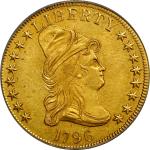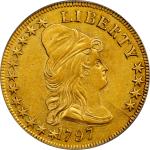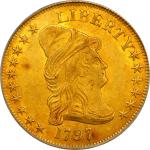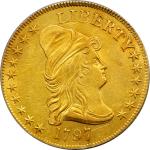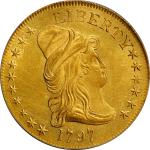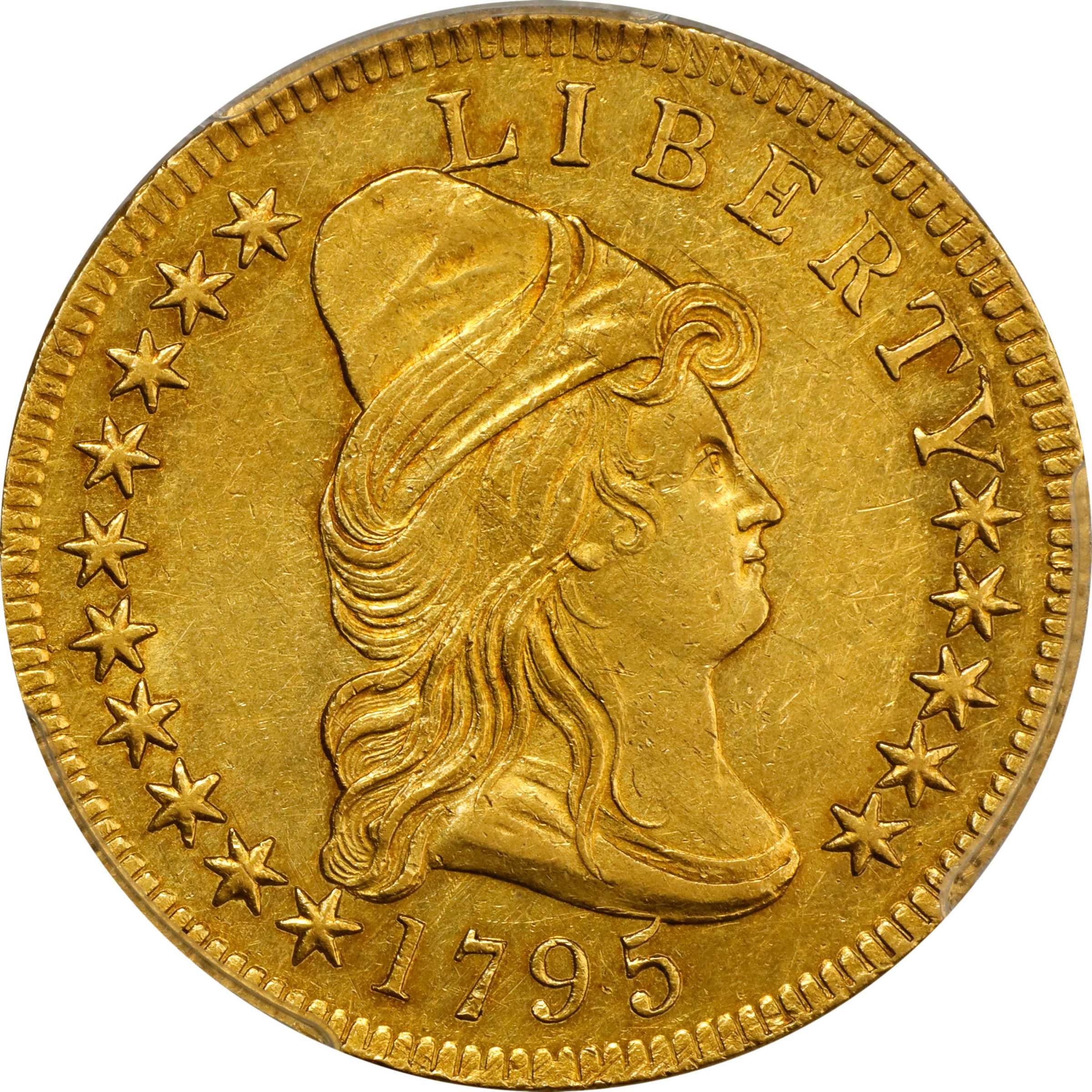1795 Capped Bust Right Eagle. BD-1, Taraszka-1. Rarity-3+. 13 Leaves. AU-58+ (PCGS). CAC. <strong>Type and Style:</strong> Type I: Capped Bust Right, Small Eagle. Style I: Head of 1795 with 15 stars arranged 10 left, five right; Reverse of 1795 with 13 leaves (sometimes called fronds) on the palm branch. The head and eagle punches are attributed to hubs prepared by Robert Scot.<p><strong>Die Variety:</strong> BD-1, Taraszka-1, Breen 1-A, HBCC-3169. On the obverse, the tip of the digit 5 in the date is over the bust, the left base of the letter L in LIBERTY touches Libertys cap, star 11 is close to the letter Y in LIBERTY, and the upper left serif of the same letter is elongated by a small die line. The reverse is most readily identifiable by looking at the eighth leaf on the palm branch, which nearly touches the letter U in UNITED. This variety represents the first and only use of this obverse die. The reverse was later used to strike eagles of the BD-2, Taraszka-2 variety.<p><strong>Die State:</strong> BD Die State b/a-b. A delicate die crack connects the outer points of stars 3 to 9 on the obverse, and there is a small die lump between the outermost point of star 5 and the border. The reverse is an intermediate die state with faint die cracks from the border above the first A in AMERICA to the upper left corner of the adjacent M and between the tops of the letters ED in UNITED. Other die cracks for DB Die State b are not present, however, including ones that would eventually form from the eagles right wing tip to the letter T in UNITED, from the border to the letter D in UNITED, and through the letters ER in AMERICA and the eagles left wing tip. In a later state (BD Die State c), the aforementioned obverse die crack would eventually extend through all stars on the left, as well as through the base of the digits 179 in the date, and another crack would develop through stars 14 and 15 to the end of Libertys bust. Die State c is the latest state known for the obverse, although the terminal state probably featured clashing that forced Mint personnel to retire the die. (For more on this, see below in our discussion of the die state for the BD-2, Taraszka-2 example in this collection.)<p><strong>Estimated Mintage for the Issue:</strong> Most Capped Bust Right, Small Eagle tens were struck from 1795-dated dies. The mintage for calendar year 1795 is 5,583 coins, per Mint records. John W. Dannreuther (<em>Early U.S. Gold Coin Varieties: A Study of Die States, 1795-1834</em>, 2006) provides an estimate of coins struck from 1795-dated dies that ranges from a low of 5,859 to a high of 10,915 pieces.<p><strong>Estimated Mintage for the Variety:</strong> Dannreuther estimates that 2,795 to 5,583 eagles were struck from the 1795 BD-1 die marriage.<p><strong>Estimated Surviving Population for the Variety:</strong> Only 225 to 325 coins at all levels of preservation (per Dannreuther). BD-1 is the most frequently encountered die variety of the issue.<p><strong>Strike:</strong> This is an expertly produced coin by early U.S. Mint standards. Both sides are ideally centered within fully and uniformly denticulated borders. We note only a touch of softness to the centers, a few of Libertys hair tresses behind the ear and some of the eagles neck and breast feathers are indistinct. All other design elements are boldly defined.<p><strong>Surfaces:</strong> Both sides are noticeably semi-prooflike with appreciable reflectivity in the fields. Otherwise medium golden-orange, the surfaces exhibit warmer reddish-rose outlines to many of the design elements, especially on the reverse. There are only wispy handling marks from commerce, the most useful identifying features are a tiny flan flaw at the reverse border below the first palm leaf and a few wispy scuffs nearby in the field below the second and third leaves.<p><strong>Commentary:</strong> The Mint Act of April 2, 1792, established the $10 gold coin, or eagle, as the United States highest denomination. The first examples were struck in 1795, arguably the most historically significant gold coins struck in the United States Mint. Although the 1795 Small Eagle $5 was the first gold coin struck by the United States Mint (in late July), no other coin symbolizes the aspirations of the nation and the American economy like the 1795 eagle. It was an ambitious denomination, first conceived by Thomas Jefferson, the author of most initial underpinnings of the American coinage system. Then serving as one of Virginias delegates to Congress, Jefferson described the eagle for the first time in his <em>Notes on the Establishment of a Money Unit and of a Coinage for the United States</em>, popularly known as his "Notes on Coinage," written in the spring of 1784. After explaining why the money unit should be pegged to the familiar Spanish milled dollar and why a decimal-based system is easier for both natives and foreigners, Jefferson suggested: "If we adopt the dollar for our unit, we should strike four coins, one of gold, two of silver, and one of copper, viz. 1. a golden piece equal in value to 10 dollars, 2. the unit or dollar itself of silver, 3. the tenth of a dollar, of silver also, 4. the hundredth of a dollar of copper." He further explored his "golden piece" in terms of two coins then common in the cash boxes of American merchants, the first made in mints in Portugal and Brazil, the second a standard English gold coin, noting that the eagle "will be 1/5 more than a half Joe and 1/15 more than a double guinea. It will be readily estimated then by reference to either of them, but more readily and accurately as equal to 10 dollars."<p>Jefferson did not coin the name "eagle" for his 10 dollar denomination. In May 1785, Jefferson submitted his <em>Propositions Respecting the Coinage of Gold, Silver, and Copper</em>, in which he referred to the largest gold coin of the newly independent republic as the "crown," an ironic choice that first appears in Gouverneur Morris 1783 writings regarding a very different coinage scheme. Jefferson was not terribly fond of the title, as he remarked "as to the names above chosen, they, like all other names, are arbitrary, and better may perhaps be substituted." A letter from Jefferson to William Carmichael, dated November 4, 1785, reveals that the question of denominations had still not been decided. Virginia delegate James Monroe reported to Jefferson, then in Paris, in January 1786 that "the subject of the mint...will be taken up again so soon as we have 9 or 10 states (for at present we have but 7)." It took eight more months, but Congress finally came to a resolution on a coinage system on August 8, 1786, declaring that the coin "equal to ten dollars, to be stamped with the impression of the American eagle [would] be called An Eagle." Not everyone loved the name. Edmund Pendleton, a Virginia planter and politician, wrote to James Madison in December 1786 to complain about the new federal government prerogative to coin money, a power formerly held by the states. He preferred the former system by which the central government merely regulated the value of the coins then circulating, "leaving it to each [state] to coin any bullion they might fortunately meet with at home and in such pieces as their convenience should direct, whether in Eagles or Sparrows, so they conformed to the rules prescribed." Alexander Hamilton, befitting his reputation, was more direct, writing in his 1791 report "On the Establishment of a Mint" that "the eagle is not a very expressive or apt appellation for the largest gold piece, but nothing better occurs." Thus, the name remained, as did the denomination, first struck in September 1795 and last coined in 1933.<p>The first eagles are large and impressive coins, measuring approximately 33 millimeters and weighing 17.50 grams. The composition is an alloy of .9167 gold and .0833 silver and copper. These standards for size, weight and composition would remain current until Jefferson, then as president, halted eagle production in 1804. When coinage of this denomination resumed in 1838, the coins were smaller, lighter and made of an alloy of .900 gold and .100 copper, per the Coinage Act of June 28, 1834.<p>Numismatists have long referred to the design of the United States Mints first eagles as the Capped Bust Right, Small Eagle, this type the work of Robert Scot, first chief engraver of the United States Mint. However, as Capped Bust is also the popular name of a different style introduced by John Reich on silver coins in 1807, it has been suggested that another name such as Conical Cap Right be used. The obverse depicts a draped bust of Liberty facing right with flowing hair and a turban-like cap. The word LIBERTY is above, the date is below and, depending on the date of the specific coin in question, 15, 16 or 13 stars are arranged around the border. The reverse design, which is particularly elegant, features an eagle with outstretched wings grasping a palm branch in its talons and a wreath without berries in its beak. The legend UNITED STATES OF AMERICA is around the border, the tips of the eagles wings intruding into the lettering. There is no expression of the denomination on either side of these early eagles, whose value was determined based on the precious metal content and weight. In fact, to speak of the early eagle as a denomination is actually a misnomer for, as Dannreuther states, "Even though a gold eagle was denominated as a ten-dollar coin, our forefathers traded gold by the tale...<em>Tale</em>, in this instance, means count or tally, the number of things taken together (i.e., the weight and purity of an individual coin)." Scots design is said (by Walter Breen) to have been copied from an ancient cameo, perhaps explaining the use of a palm branch on the reverse, otherwise unusual.<p>Scots Capped Bust Right obverse, Small Eagle reverse motif combination was only used on eagles dated 1795, 1796 and 1797. The total mintage for this type is estimated at 10,609 to 18,676 pieces (per Dannreuther). A word on mintages for early U.S. Mint coins is perhaps in order here. The figures provided in government archives represent the number of examples struck in any given calendar year, but do not necessarily correspond to the number of coins struck from dies bearing that date. The early United States Mint experienced considerable difficulty procuring high quality steel for making dies. Functional dies, therefore, were often used until they failed, even if the date on the coins did not match the calendar year. Additionally, early U.S. Mint gold and silver coins were not struck on government account but, rather, at the request of bullion depositors who requested coins of a certain denomination in exchange for their precious metal. When they received a new warrant for coinage, Mint personnel often utilized whatever functional dies were at hand to fill that warrant, again without regard for whether the date on the coins being struck matched the calendar year. With these facts in mind, numismatic scholars have had to estimate the number of coins struck for individual issues and varieties in the early eagle series based primarily on the number of coins extant, of course with consideration for the yearly mintage figures provided in Mint records. In fact, Dannreuthers estimate of 10,609 to 18,676 Capped Bust Right, Small Eagle tens produced encompasses the total of 13,344 coins struck provided in the <em>Guide Book of United States Coins</em> (the Red Book), the latter of which is based more closely on yearly mintage figures as reported in Mint records.<p>Attrition for early eagles of 1795 to 1804 was extremely high. Although it is likely that some pieces circulated in commerce in the 1790s, afterward many if not most were exported and melted. Indeed, the exportation of eagles and the subsequent loss of gold had become so great by the earliest years of the 19th century that President Thomas Jefferson halted production of this denomination in 1804. Coinage did not resume until 1838; in the intervening years the half eagle was the highest denomination U.S. coin. The coinage of silver dollars, the highest silver denomination, was stopped as well (and did not resume until 1836). Most numismatic scholars believe that fewer than 1% of early eagles struck have survived to the present day. All dates and varieties in this series are scarce, and some are exceedingly rare.<p>Five die marriages of the 1795-dated issue are known, and they feature two obverse and three reverse dies. BD-1, represented here, is widely regarded as the first eagle produced. Evidence for this prominent placement in U.S. coinage history stems from the fact that this is most frequently encountered of the five known die varieties of this issue, first year issues and varieties often being saved in significant numbers due to their novelty. Additionally, several prooflike 1795 BD-1 eagles are known, and Dannreuther reports the possible existence of at least one presentation striking (described by the early U.S. Mint as a "master coin"). One of the prooflike coins is in the National Numismatic Collection at the Smithsonian Institution, and it was once owned by Chief Coiner Henry Voigt and Adam Eckfeldt. These specially prepared and preserved coins would undoubtedly have been among the first eagles produced, providing further evidence for the status of BD-1 as the first 1795 eagle variety. As a lovely Choice About Uncirculated survivor of the historic first year 1795 Capped Bust Right eagle, the coin offered here would make an impressive addition to an advanced gold type or variety set. PCGS# 8551. NGC ID: 25ZU. CAC Population (all die marriages of the issue): 4; 10. The former total includes coins certified both AU-58 and AU-58+. From the Harvey B. Jacobson Jr. Collection. Earlier ex Mid-American Rare Coin Galleries, Detroit ANA Convention, August 1994; Anthony J. Taraszka; our sale of the Anthony J. Taraszka Collection, August 2019 ANA Auction, lot 4001; Ron Karp; 2020. The plate coin for the die variety in the book <em>United States Ten Dollar Gold Eagles: 1795-1804</em> by Anthony J. Taraszka.










